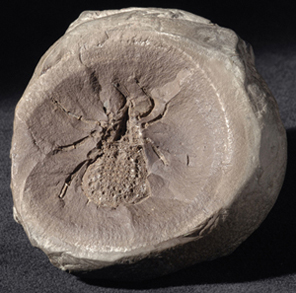Giant Spider Mite Fossil
This spider-like arthropod is called a trigonotarbid. . . .
More about the giant spider mite:
This Spider-like arthropod, or trigonotarbid, lived in the warm, tropical forests that covered what is now the West Midlands. . . and found in the Upper Carboniferous layer. These forests are now preserved as the Coal Measures.
Coal was extracted from deep mines in the Dudley-Coseley area of the Black Country. It was the coal from these mines that helped to drive the industrial revolution. These mines are now all closed.
This arthropod is preserved in a nodule rich in iron that was found with the coal. The coal and iron-rich nodules formed in a swampy, oxygen poor environment. The lack of oxygen slowed down decay, and allowed the Spider Mite, as well as other animals and plants living at the same time, to be preserved in three-dimensions. Sometimes even soft parts are preserved.
The arthropod originally belonged to E.J. Hollier, who was mayor of Dudley in the nineteenth century. Hollier also ran a chemists shop and sold fossils.
This fossil had recently been scanned in a hospital using Computed Tomography (CT) scanning. CT scanning has revealed many of the parts of the fossil still buried inside the nodule.
This Giant Fossil arthropod is part of the collections held at the Lapworth Museum, University of Birmingham. Use the ‘Lapworth Museum of Geoogy’ web link below to find out more about the Collections at the Lapworth Museum.
http://www.thinktank.ac/page.asp?section=487§ionTitle=fossil+Spider+mite

If thats a Spider Mite…how BIG was the spider?